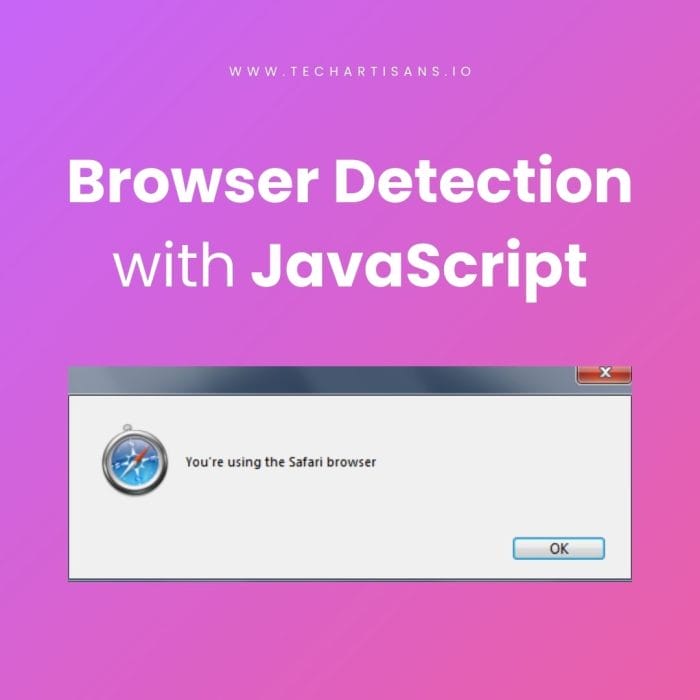In the ever-evolving digital world, tailoring user experience is vital for the success of any online business. One way to achieve this is through JavaScript detect browser – A valuable tool, JavaScript, allows you to tailor content for different browsers, improving the user interface. Ensuring your web pages appear correctly across different browsers enhances the user experience. This is vital for small to medium businesses aiming to please and keep their online customers by enhancing website functionality and ease of use.
Browser Detection with JavaScript
Let’s unleash the potential of your website with JavaScript’s ability to effectively detect various browsers.
Learn more about Easy Ways to Insert Spaces in HTML
1. Basics of Browser Detection
Browser detection with JavaScript involves identifying the user’s browser type and version. This allows you to deliver tailored, optimized content for each distinct browser, enhancing user experience.
Read more about Types of Web Design for Website
2. The Navigator.userAgent Property
The navigator.userAgent property in JavaScript is crucial for browser detection. It provides a string containing the browser’s name, version, and platform. While it can be spoofed, it is useful for identifying the browser and tailoring website content for compatibility. It’s best used with feature detection for reliable browser detection.
3. User-Agent Header Strings in Browsers
When you visit a website, your web browser sends a request to the server. In this request, the “User-Agent” header tells the server what browser and operating system you use. This facilitates the server in delivering a webpage optimized for seamless compatibility with your configuration. But it’s worth noting that some tech-savvy users can change this information to make their browser look like a different one.
Why Detecting Browsers is Important
Detecting browsers is a pivotal aspect of web development and optimization, playing a significant role in delivering a personalized and efficient user experience. Let’s delve into why it’s so crucial.
1. Tailoring User Experience For Different Browsers
Different browsers render websites in distinct ways, causing variations in the user experience. By detecting the browser type with JavaScript, businesses can customize their website’s look, functionality, and performance to match the unique characteristics of each browser. This approach ensures optimal display and interaction, enhancing user satisfaction and potentially increasing business conversion rates.
Find Out Web Design Checklists
2. Challenges With Cross-browser Compatibility
Cross-browser compatibility poses a challenge due to the variations in how browsers interpret and display web content. These inconsistencies can lead to visual and interactive disparities, ultimately impacting the user experience. Even slight variations in JavaScript implementation across browsers can cause functionality issues.
Read Source Code vs. Object Code: Unraveling the Distinctions
Methods for Browser Detection
Let’s explore the techniques you can employ for effective browser detection, ensuring that your website delivers a consistent and engaging user experience for all visitors, regardless of their browser choice.
1. Using the indexOf() Method to Detect Specific Strings
The indexOf() method in JavaScript is like a detective for strings. It scans a text for a particular word or phrase and indicates the location where it identifies it. If it doesn’t find it, it says “I couldn’t find it” by returning -1. This is handy for figuring out what browser someone uses by searching in their userAgent string.
Learn Responsive Web Design Best Practices
Applying this to browser detection, we can use `indexOf()` to scan the `userAgent` string for certain key phrases linked to different browsers. For example, the string “Chrome” within `userAgent` would indicate that the user is accessing the site via Google Chrome. Here’s a sample code snippet to illustrate this concept:
“`javascript
var userAgent = navigator.userAgent;
if (userAgent.indexOf(“Chrome”) != -1) {
// The browser is Google Chrome
}
“`
This method is a simple and effective means of browser detection. However, it’s crucial to remember that the `userAgent` string can be altered by users.
2. Detecting Popular Browsers
We can utilize certain unique aspects of their `userAgent` strings to detect specific browsers using JavaScript.
Explore more about What is Responsive Design
Google Chrome: Chrome’s `userAgent` string contains both “Chrome” and “Safari” substrings, sometimes leading to a false positive for Safari. To avoid this, we look for the presence of “Chrome” along with the absence of “Edge” and “OPR,” which are specific to Edge and Opera, respectively.
“`javascript
if ((userAgent.indexOf(“Chrome”) != -1) && (userAgent.indexOf(“Edg”) == -1) && (userAgent.indexOf(“OPR”) == -1)) {
// The browser is Google Chrome
}
“`
Mozilla Firefox: Firefox can be identified by the presence of “Firefox” in the `userAgent` string.
“`javascript
if (userAgent.indexOf(“Firefox”) != -1) {
// The browser is Mozilla Firefox
}
“`
Safari: To identify Safari, we look for “Safari” in the `userAgent` string while simultaneously ensuring the absence of “Chrome” and “Chromium” to exclude Chrome-related browsers.
“`javascript
if ((userAgent.indexOf(“Safari”) != -1) && (userAgent.indexOf(“Chrome”) == -1) && (userAgent.indexOf(“Chromium”) == -1)) {
// The browser is Safari
}
“`
Internet Explorer: Internet Explorer can be detected by looking for “MSIE” or “Trident” (its engine) in the `userAgent` string.
“`javascript
if ((userAgent.indexOf(“MSIE”) != -1) || (userAgent.indexOf(“Trident”) != -1)) {
// The browser is Internet Explorer
}
“`
Opera: Opera can be detected in a modern setting by looking for “OPR” in the `userAgent` string.
“`javascript
if (userAgent.indexOf(“OPR”) != -1) {
// The browser is Opera
}
“`
Edge: Edge can be detected by looking for “Edg” in the `userAgent` string.
“`javascript
if (userAgent.indexOf(“Edg”) != -1) {
// The browser is Edge
}
“`
Remember, users could spoof’ userAgent’ strings; hence, these methods should be used alongside feature detection techniques for dependable browser detection.
3. JavaScript Functions for Browser Detection
Google Chrome: We can create a function that returns true if the browser is Chrome. It checks for “Chrome” in the userAgent string and ensures “Edge” and “OPR” aren’t present to avoid false positives.
“`javascript
function isChrome() {
return userAgent.indexOf(‘Chrome’) > -1 && userAgent.indexOf(‘Edg’) == -1 && userAgent.indexOf(‘OPR’) == -1;
}
“`
Mozilla Firefox: The function for Firefox detection simply looks for “Firefox” in the userAgent string.
“`javascript
function isFirefox() {
return userAgent.indexOf(‘Firefox’) > -1;
}
“`
Remember, these functions are not foolproof due to the potential for user-agent spoofing. They should be used alongside other browser and feature detection methods for a more reliable solution.
Limitations and Concerns
While JavaScript browser detection techniques are immensely useful, they come with limitations and concerns that must be recognized and understood for effective implementation.
1. Limitations of Browser Detection
Relying on browser detection has its drawbacks. Most Common Web Security Vulnerabilities Offers insight into web security, a vital consideration when discussing the limitations of browser detection.
Users or plugins can easily fake their UserAgent strings, making them unreliable. Also, keeping an updated list of UserAgent strings is tough with frequent browser updates. A better approach is feature detection, where you check if certain functions work rather than trying to guess the browser. This method is more dependable.
2. Challenges with User-Agent Strings
The dynamic nature of user-agent strings poses a significant issue in browser detection. Users or automated scripts can easily modify these strings, leading to false browser identification, often called false positives. This variability emphasizes the need for supplementary detection methods, such as feature detection, which assesses browser capabilities directly, providing a more reliable approach to browser identification.
3. Risks of Relying Solely on Navigator User-Agent
Relying solely on the `navigator.userAgent` for browser detection carries risks. UserAgent strings can be modified, leading to false identifications. Furthermore, the rapid evolution of browsers means that UserAgent strings constantly change, making it hard to maintain an accurate detection system.
Best Practices
When implementing JavaScript browser detection in your applications, following best practices can help you achieve reliable results and mitigate potential challenges.
1. Designing Websites For Cross-browser Compatibility
Designing your website for cross-browser compatibility is essential. Web Design Process Provides a comprehensive look at the web design process, aiding in achieving cross-browser compatibility. It ensures your website’s functionality and appearance are consistent across different browsers. Standardized web technologies and thorough testing across multiple browsers and devices can achieve this.
2. Balancing Browser Detection
Use browser detection sparingly due to its limitations and the changing user-agent strings. Prioritize feature detection for cross-browser compatibility. Regularly update detection scripts to identify new browsers and maintain accuracy.
Real-world Applications
Here, we will explore some compelling real-world applications where ‘JavaScript detect browser’ has proven to be a pivotal tool.
1. Customizing Website for Browser Types
JavaScript browser detection can tailor website features or content according to visitors’ browser type. Benefits of Having a Website Explores the broader benefits of owning a website, supplementing the discussion on browser-specific customization.
This can result in a more personalized user experience, as certain functionalities or design elements might be more compatible or visually appealing on specific browsers. For instance, a website feature that runs smoothly on Chrome might not perform as well on Firefox, so using JavaScript for browser detection enables developers to optimize the user experience based on their browser.
2. Debugging Browser-specific Issues
JavaScript browser detection can be instrumental in debugging browser-specific issues. For instance, a functionality that works flawlessly in one browser may exhibit bugs in another. By detecting the browser type, developers can isolate and address these browser-specific problems, enhancing the overall user experience and website performance. This fosters a smooth, consistent user experience across various browsers.
3. Enhancing User Experience
Understanding browser capabilities through JavaScript browser detection helps enhance the user experience. It enables the development of tailored experiences based on the browser’s unique abilities and limitations. This means serving high-resolution images to browsers that support them or providing alternative content to those without, ensuring optimal user experience across different browsers.
Conclusion
Using JavaScript to detect browsers helps create a personalized user experience based on what browsers people use. User Experience SEO Offers further reading on the intersection of user experience and SEO, relevant to the article’s focus on browser detection. Although there are some challenges, like UserAgent spoofing and changing UserAgent strings, the benefits are worth it.
These benefits include customizing website content, fixing browser-specific problems, and improving the user experience. Why UX Design is Important Provides a deeper dive into UX design, tying in well with the article’s emphasis on enhancing user experience through browser detection.
Therefore, it’s crucial to understand these techniques, their applications, and best practices to effectively use JavaScript detect browsers in creating a seamless and engaging digital experience for users across different browsers.







